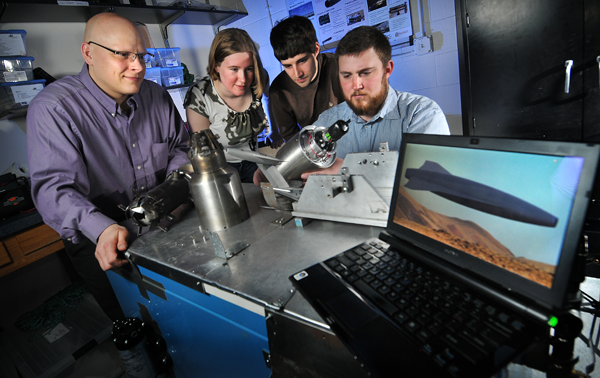CU team’s efficient, unmanned aircraft jetting toward commercialization
CU-Boulder assistant professor Ryan Starkey, left, with members of his team, looks over engine model nozzles for a first-of-its-kind supersonic unmanned aircraft vehicle, visible in the rendering on the computer screen. From left: Starkey; Sibylle Walter, doctoral student; Josh Fromm, master’s graduate; and Greg Rancourt, master’s student. (Photo by Glenn Asakawa/University of Colorado)
Propulsion by a novel jet engine is the crux of the innovation behind a University of Colorado Boulder-developed aircraft that’s accelerating toward commercialization.
Jet engine technology can be small, fuel-efficient and cost-effective, at least with assistant professor Ryan Starkey’s design. The CU-Boulder aerospace engineer, with a team of students, has developed a first-of-its-kind supersonic unmanned aircraft vehicle, or UAV. The UAV, which is currently in a prototype state, is expected to fly farther and faster -- using less fuel -- than anything remotely similar to date.
The fuel efficiency of the engine that powers the 50-kilogram UAV already is double that of similar-scale engines, and Starkey says he hopes to double that efficiency again through further engineering.
Starkey says his UAV could be used for everything from penetrating and analyzing storms to military reconnaissance missions -- both expeditions that can require the long-distance, high-speed travel his UAV will deliver -- without placing human pilots in danger. The UAV also could be used for testing low-sonic-boom supersonic transport aircraft technology, which his team is working toward designing.
The UAV is intended to shape the next generation of flight experimentation after post-World War II rocket-powered research aircraft, like the legendary North American X-15, have long been retired.
“I believe that what we’re going to do is reinvigorate the testing world, and that’s what we’re pushing to do,” Starkey said. “The group of students who are working on this are very excited because we’re not just creeping into something with incremental change, we’re creeping in with monumental change and trying to shake up the ground.”
Its thrust capacity makes the aircraft capable of reaching Mach 1.4, which is slightly faster than the speed of sound. Starkey says that regardless of the speed reached by the UAV, the aircraft will break the world record for speed in its weight class.
Its compact airframe is about 5 feet wide and 6 feet long. The aircraft costs between $50,000 and $100,000 -- a relatively small price tag in a field that can advance only through testing, which sometimes means equipment loss.
Starkey’s technology -- three years in the making at CU-Boulder -- is transitioning into a business venture through his weeks-old Starkey Aerospace Corp., called Starcor for short. The company was incubated by eSpace, which is a CU-affiliated nonprofit organization that supports entrepreneurial space companies. Starkey’s UAV already has garnered interest from the U.S. Army, Navy, Defense Advanced Research Projects Agency and NASA. The acclaimed Aviation Week publication also has highlighted Starkey’s UAV.
Starkey says technology transfer is important because it parlays university research into real-life applications that advance societies and contribute to local and global economies.
It also can provide job tracks for undergraduate and graduate students, says Starkey who’s bringing some of the roughly 50 students involved in UAV development into his budding Starcor.
“There are great students everywhere, but one of the reasons why I came to CU was because of how the students are trained. We definitely make sure they understand everything from circuit board wiring to going into the shop and building something,” Starkey said. “It makes them very effective and powerful even as fresh engineers with bachelor’s degrees. They’re very good students to hire. That’s a piece that I’m interested in embracing -- finding the really good talent that we have right here in Colorado and pulling it into the company.”
Starkey and his students are currently creating a fully integrated and functioning engineering test unit of the UAV, which will be followed by a critical design review after resolving any problems. The building of the aircraft and process of applying for FAA approval to test it in the air will carry into next year.
Starkey’s fascination with speed first began to burn inside of him when he visited Kennedy Space Center at age 5.
“When I teach, I tell my class, ‘If it goes fast and gets hot, I’m in it.’ That’s what I want to do. There needs to be fire involved somewhere.”


